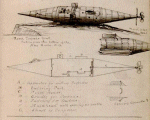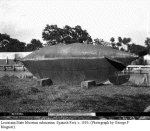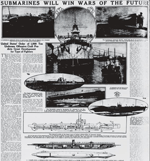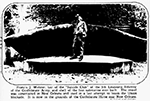| Click On Image For Full Size | Size | Image Description | Source By |
|
|---|---|---|---|---|
| Pioneer | ||||
 | 253k | The Confederate submarine Pioneer's measured drawings given to William Shock, Fleet Engineer of the Western Gulf Blockading Squadron in 1862. | Photo courtesy of National Archives / lsm.crt.state.la.us. | |
 | 44k | The Confederate submarine Pioneer drawn by Ensign David M. Stauffer of the Mississippi Squadron, 1865. | Photo courtesy of lsm.crt.state.la.us. | |
 | 131k | 3 Photo CAD drawings of the Pioneer. | Photos courtesy of Walter M. Hines. | |
 | 309k | A full scale replica of the submarine Pioneer on display at the Warren Lasch Conservation Center. | Photo courtesy of en.wikipedia.org via Robert Hurst. | |
| Louisiana State Museum Submarine | ||||
 | 71k | The Confederate submarine thought to be the Pioneer was found in 1878, but the one shown here is actually a different model. The following text and photos dealing with a Civil War Era sub appear at Louisiana State Museum The history of the museum's submarine can be traced to 1878 when it was removed from Lake Pontchartrain and placed on the levee by a dredge crew working near the mouth of Bayou St. John. For years after its recovery, the boat lay neglected on the lakeshore. By 1895, it was placed on display at Spanish Fort where it became a prominent landmark. A period of neglect followed, during which the submarine was taken from its wooden stand at the Fort and left lying in the weeds. A remaining propeller blade was removed by vandals and large areas of loss appeared along the lower hull. Later, in 1908, it was moved to the Camp Nicholls Confederate Home on Bayou St. John. In 1942, it was acquired by the State Museum and moved to Jackson Square. Some years later the museum transferred it into the lower Pontalba Building, where it was featured in a "Defense Exhibit." It was eventually moved under the Presbytere arcade in 1957 before being transferred to the conservatory in December of 1999. The Louisiana State Museum submarine once was thought to have an identity. It was believed to be the Pioneer, a vessel built in New Orleans by a group led by Horace Hunley, a wealthy lawyer and customs agent. Recent findings in the National Archives, however, have proven otherwise. The Pioneer was established by a letter of marque by the Confederate government as a privateer in March of 1862. Only a month later, however, New Orleans fell to David Glasgow Farragut, commander of the West Gulf Blockading Squadron, and the Pioneer was scuttled in a New Orleans canal. When the submarine was discovered, a team of Union experts examined it and prepared measured drawings to be sent to Washington for further study. It was these drawings and descriptions, found only three years ago by naval historian Mark Ragan, that showed the Pioneer to be a different vessel than the one owned by the State Museum. While the Pioneer was described as cigar shaped, 30 feet long and 4 feet in diameter, the New Orleans submarine is shaped more like a pumpkinseed, and is 20 feet long, 3 feet wide and 6 feet deep. The submarine still has a propeller shaft and gear that were part of its propulsion system. It was powered by two people who either hand cranked or pedaled the propeller. In the bow of the vessel were controls for a third man to adjust the diving planes and the bow and stern rudders. There is evidence of a sophisticated system to turn the bow and stern rudders simultaneously. Louisiana State Museum Submarine is shown at the Spanish Fort on Lake Ponchartrain, northeast of New orleans, about 1880. Her propeller hub (without blades) is on the stern at the left, the rudder and diving planes are in the bow, at right. | Photo & partial text courtesy of U.S. Submarines Through 1945, An Illustrated Design History by Norman Friedman. Naval Institute Press. | |
 | 48k | The Louisiana State Museum Submarine at the Spanish Fort Amusment Park, circa 1895. | Photo by George Mungier / courtesy of lsm.crt.state.la.us. | |
 | 152k | The Louisiana State Museum Submarine being transported from the Presbytere arcade to the Euphrosyne Conservation Center, December 1999. | Photo courtesy of Louisiana State Museum. | |
 | 1.46k | SUBMARINES WILL WIN WARS OF THE FUTURE A Confederate submarine driven by hand. The crew of negroes were drowned when the boat was given an experimental submergence. The Confederate submarine Hunley, which sank, the Houstanic. The biggest commissioned submersible in the United States navy. The GL, of 450 tons submerged displacement. A boat of the Lake type. | Image and text provided by The New York Public Library, Astor, Lenox and Tilden Foundation. Photo by The Sun. (New York, [N.Y.]) 1916-1920, 14 March 1915, FOURTH SECTION PICTORIAL MAGAZINE, Image 40, courtesy of chroniclingamerica.loc.gov. | |
 | 729k | Francis J. Wehner, last of the “Suicide Club” of the 5th Louisiana Infantry of the Confederate Army, and shell of the first submarine ever built. The vessel was constructed in New Orleans and was used in a last attempt to break the Union blockade. It is now in the grounds of the Confederate Home near New Orleans. | Image and text provided by Library of Congress, Washington, DC. Photo by Evening Star.[volume] (Washington, D.C.) 1854-1972, 07 September 1924, Image 85, courtesy of chroniclingamerica.loc.gov. | |
Additional Resources and Web Sites of Interest
HISTORIC SUBMARINE DOCUMENTARY AND TRAINING FILMS
Submarine History / An Illustrated Survey of Key Events in Submarine History
| Back To The Main Photo Index | Back To the Submarine Index |
| Problems and site related matters, E-mail Webmaster |
| This page is partially inspired by Robert Hurst & created and maintained by Michael Mohl All Pages © 1996 - 2023, NavSource History All rights reserved. |